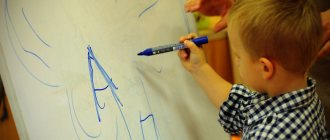The main stages of child development
During this period, dependence on an adult is comprehensive.By the age of one year, the child pronounces his first words, at which time the foundations of speech skills are laid. Children themselves lay these foundations, striving to establish contact with adults through crying, humming, cooing, babbling, gestures, and then their first words.
Toys are of great importance in mastering objective activities. Children develop knowledge about people and surrounding objects based on information received from their own senses and random movements.
The need of age is the need for safety and security. This is the main function of an adult. If a child feels safe, then he is open to the world around him, he will trust him and explore it more boldly. If not, it limits interaction with the world to a closed situation. At a young age, a person develops a feeling of trust or distrust in the world around him (people, things, phenomena), which the person will carry throughout his life. A feeling of alienation occurs when there is a lack of attention, love, affection, or when children are abused.
At the same age, a feeling of attachment is formed.
Development of movements and actions.
During the first year of life, the child achieves great success, mastering movement in space and simple actions with objects.
He learns to hold his head up, sit up, crawl, move on all fours, assume a vertical position and take several steps; begins to reach for objects, grab and hold them, and finally, manipulate (act with objects) them - wave, throw, tap on the crib, etc. The joint activity of an adult and a child consists in the fact that the adult directs the actions of the infant, and also in the fact that the infant, being unable to perform any action himself, turns to the help and assistance of an adult.
Development of orientation in the surrounding world. As new types of movement are mastered and improved, the child’s orientation in the properties and relationships of objects and in the surrounding space is formed.
The actions that a child masters under the guidance of an adult create the basis for mental development. The baby's dependence on adults leads to the fact that the child's attitude to reality and to himself is always refracted through the prism of relationships with another person. In other words, the child’s relationship to reality turns out to be a social, social relationship from the very beginning.
The prerequisites for speech acquisition are being formed.
The need for communication creates the basis for the emergence of imitation of the sounds of human speech.
The physiological immaturity of an infant is characterized not only by a lag in the development of physiological functions that arose in him already in the prenatal period, but also by a later weakening of their intensity compared to a physiologically mature newborn.
During the first 7 years of life, a child goes through a gigantic developmental path, the determining factors of which are the environment and upbringing. Every educational process begins with respect for the child as an individual. It should be noted that human personality is not only formed in childhood, but already exists at this age. Many of the foundations of individuality are determined by the characteristics of the nervous system, congenital and inherited, age-related and acquired. It has been established that the properties of the nervous system play a huge role in the development of a child. The age-related evolution of a child’s brain is a complex and multifaceted process. L. S. Vygotsky wrote that the development of a child is a single, but not homogeneous, holistic, but not homogeneous process.
The totality of the child’s individual characteristics constitutes the “biological framework of the personality,” which not only acquires social skills in the process of upbringing, but also undergoes changes.
The development of a child and his nervous processes is greatly influenced by the development of motor functions. Their maturation is associated with the activity of the motor analyzer. Its development. It occurs on the basis of distant receptors - vision and hearing, as well as the tactile-muscular analyzer and plays a crucial role in the psychophysical development of the child.
At birth, humans have fewer “automatic” actions than animals, but they have the greatest ability to learn. The specificity of the human brain lies in the unlimited ability to assimilate new knowledge, the greatest susceptibility not to biological heredity, but to “social inheritance,” i.e. to the assimilation of various kinds of social traditions.
The development of the child’s central nervous system occurs on the basis of innate unconditioned reflexes. In physiologically mature newborns, evoked reflexes appear in response to irritation of various areas of the skin surface. First of all, this is the grasping reflex (for example, a newborn who grabs onto the fingers of an adult can be lifted, his grip is able to withstand body weight). The plantar reflex, which is caused by line irritation of the skin surface of the inner edge of the sole, is characterized by extension of the big toe and flexion of the rest. The heel reflex, known as the I.N. Arshavsky reflex, is caused by moderate pressure on the heel bone and is expressed in generalized motor activity, combined with a crying grimace and scream. A newborn baby also has walking and crawling reflexes. They gradually collapse and are re-formed under the influence of upbringing. The development of the nervous system occurs on the basis of other innate reflexes: food, orientation, defensive, protective.
From the first weeks of a child’s life, conditioned reflexes arise to a wide variety of stimuli (visual, auditory, etc.).
Long-term use of any external stimuli in a certain sequence contributes to the formation of an integral system of responses - a dynamic stereotype.
The formation of conditioned reflexes in a child occurs in the interrelation of the first and second signaling systems.
The central nervous system of a child contains traces of the long evolution of the animal world. Thus, the regulation of the functioning of the heart, kidneys and other internal organs, automatic reactions to pain and temperature stimuli are carried out by approximately the same nerve centers as in many animals. In the child’s nervous system, some groups of centers, evolutionarily more ancient, perform relatively primitive functions. Evolutionarily newer centers unite various body systems and perform multifaceted complex actions. Thus, the center of the spinal cord regulates the functioning of organs within individual sections of the body segments. The centers of the medulla oblongata control breathing and cardiac activity. The centers of the midbrain carry out a complex reaction of the entire organism in response to visual and auditory stimuli. In the area of the diencephalon and in the subcortical nodes, all signals from the external and internal environment are integrated. As experiments show, an emotional state is formed here - a feeling of fear, tension, joy, aggressiveness. Physiologists have proven the presence in the subcortical centers of areas whose irritation causes various emotional states: anger, bliss, fear, indifference.
A complex system of deep centers is controlled by the cerebral cortex. On the one hand, it cannot function without these structures, and on the other, it compares the signals received from them with individual experience and controls the activation or inhibition of individual nerve centers.
Thus, the functions of the cerebral cortex are the ability to subtly analyze the situation, acquire and, if necessary, use individual experience. Some reactions are hard-coded in the nervous system and are launched as an automatic sequence of actions, while others are unstable and change during the process of their implementation.
Age-related development of the child. Early age
Characteristics of early age
Early childhood covers the period from 1 year to 3 years. During this period, the social situation of the child’s development changes. By the beginning of early childhood, the child, acquiring the desire for independence and independence from the adult, remains connected with the adult, because he needs his practical help, assessment and attention. This contradiction finds resolution in the new social situation of the child’s development, which represents cooperation or joint activity of the child and the adult.
The child’s leading activities also change. If the infant has not yet identified the method of action with an object and its purpose, then already in the second year of life the content of the child’s objective cooperation with an adult becomes the assimilation of socially developed ways of using objects. The adult not only gives the child an object, but together with the object “transmits” the way of acting with it.
In such cooperation, communication ceases to be the leading activity; it becomes a means of mastering social ways of using objects.
At an early age, intensive mental development occurs, the main components of which are:
• subject activity and business communication with adults;
• active speech;
• arbitrary behavior;
• developing the need to communicate with peers;
• the beginning of a symbolic game;
• self-awareness and independence
At an early age, a child has a very special attitude to reality; this feature is usually called situationalism. Situationalism is the dependence of the child’s behavior and psyche on the perceived situation. Perception and feeling are not yet separated from each other and represent an inextricable unity that causes direct action in the situation. Things have a special attractive force for a child. The child perceives a thing directly here and now, without bringing his own ideas and knowledge about other things into the situation.
Communication with peers
In infancy, the manifestation of interest of one child in another is dictated by the need for new impressions, interest in a living object.
At an early age, a peer acts as an interaction partner. The development of the need to communicate with peers goes through a number of stages:
• attention and interest in peers (second year of life);
• the desire to attract the attention of peers and demonstrate their successes (end of the second year of life);
• the emergence of sensitivity to the attitude of a peer and its influences (third year of life).
Children’s communication with each other at an early age takes the form of emotional and practical influence, the characteristic features of which are spontaneity, lack of substantive content, irregularity, mirror reflection of the actions and movements of the partner. Through a peer, the child distinguishes himself and realizes his individual characteristics. At the same time, adults play a decisive role in organizing interaction between children.
Crisis of three years
By the age of three, a child develops his own desires, which often do not coincide with the desires of an adult, and there is a growing tendency towards independence, a desire to act independently of adults and without them. Towards the end of early childhood, the famous formula “I myself” appears.
A sharply increased desire for autonomy and independence leads to significant changes in the relationship between a child and an adult. This period in psychology is called the crisis of three years. This age is critical because over the course of just a few months the child’s behavior and his relationships with other people change significantly.
Symptoms of the three-year crisis:
• negativism (disobedience, unwillingness to follow the instructions of an adult, the desire to do everything the other way around);
• stubbornness (the child insists on his own not because he really wants something, but because he demanded it); • obstinacy (the child’s protest is not directed against a specific adult, but against a way of life; it is a rebellion against everything he has dealt with before);
• self-will (the child wants to do everything himself and achieves independence where he knows little).
Not all children exhibit such drastic negative forms of behavior or quickly overcome them. At the same time, their personal development occurs normally. It is necessary to distinguish between an objective and a subjective crisis.
An objective crisis is an obligatory and natural stage in the development of a child’s personality, which is always accompanied by negative behavior.
The most important personal education is the child's discovery of himself. From now on, he begins to refer to himself not in the third person (“Masha wants to go home”), but consciously pronounces the pronoun “I.” The resulting “I system” marks the transition from self-knowledge to self-awareness. The emergence of the “I system” gives rise to a powerful need for independent activity. Along with this, the child moves from a world limited by objects to the world of people, where his “I” takes a new place.
Having separated from the adult, he enters into a new relationship with him. A peculiar complex of behavior is clearly manifested, which includes:
• desire to achieve results of one's activities;
• desire to demonstrate success to an adult, to gain approval;
• heightened sense of self-esteem, which manifests itself in increased sensitivity and sensitivity to recognition of achievements, emotional outbursts, and bragging.
This complex has been called "a pride of achievement." It simultaneously covers three main spheres of the child’s relationships - to the objective world, to other persons and to himself.
The essence of this new formation, which is a behavioral correlate of the three-year-old crisis, is that the child begins to see himself through the prism of his achievements, recognized and appreciated by other people.
Preschool Age
Characteristics of preschool childhood
Preschool childhood is a period of initial formation of personality, development of personal mechanisms of behavior. According to A. N. Leontyev, personal development at this age is associated, first of all, with the development of subordination or hierarchy of motives. The child’s activity, as a rule, is stimulated and directed not by separate motives, which alternate or come into conflict with each other, but by a certain subordination of motives. If the connection between the motives and the result of an action is clear to the child, then even before the action begins, he anticipates the meaning of the future product and is emotionally attuned to the process of its production. Notably, emotions can appear before an action is performed in the form of emotional anticipation.
The separation of a child from an adult at the end of early childhood leads to new relationships between them and to a new situation for the child’s development. Communication with an adult acquires an extra-situational character and is carried out in two different forms - extra-situational-cognitive and extra-situational-personal.
An image of an ideal adult appears in the child’s mind, who becomes an example for his behavior and mediates his actions. The contradiction in the social situation of a preschool child lies precisely in the gap between his desire to “be like an adult” and the impossibility of realizing this desire in practice. The only activity that allows you to resolve this contradiction is a role-playing game.
Communication of preschoolers with peers
At preschool age, other children begin to occupy an increasingly larger place in a child’s life. By about 4 years of age, a peer is a more preferred communication partner than an adult. Communication with adults has a number of specific features, including:
• richness and variety of communicative actions;
• extreme emotional intensity;
• non-standard and unregulated;
• predominance of proactive actions over reactive ones;
• little sensitivity to peer influences.
The development of communication with peers in preschool age goes through a number of stages. At the first stage (2-4 years), a peer is a partner in emotional and practical interaction, an “invisible mirror” in which the child mainly sees himself. At the second stage (4-6 years) there is a need for situational business cooperation with a peer; the content of communication becomes joint gaming activities; At the same time, the need for peer recognition and respect arises. At the third stage (6-7 years), communication with peers acquires non-situational features; stable electoral preferences emerge. By the age of 6, the child begins to perceive himself and others as a holistic personality, irreducible to individual qualities, thanks to which a personal attitude towards a peer becomes possible.
Six Year Crisis
The end of preschool age is marked by a crisis. By this time, dramatic changes occur at the physical level: rapid growth in length, changes in body proportions, loss of coordination of movements, and the appearance of the first permanent teeth. However, the main changes do not consist in changing the child’s appearance, but in changing his behavior.
External manifestations of this crisis are mannerisms, antics, and demonstrative forms of behavior. The child becomes difficult to educate and stops following the usual norms of behavior. Behind these symptoms is a loss of spontaneity. The pretentious, artificial, tense behavior of a 6-7 year old child, which is striking and seems very strange, is precisely one of the most obvious manifestations of a loss of spontaneity. The mechanism of this phenomenon is that an intellectual moment “wedges” between the experience and the action - the child wants to show something with his behavior, comes up with a new image, wants to portray something that does not actually exist.
Junior Schoolboy
Characteristics of a junior school student
From 7 to 10 years old, a child begins a new activity—learning. It is the fact that he becomes a student, a learning person, that leaves a completely new imprint on his psychological appearance and behavior. The child does not just master a certain range of knowledge. He is learning to learn. Under the influence of new educational activities, the nature of the child’s thinking, his attention and memory changes.
Now his position in society is that of a person who is engaged in important work that is valued by society. This entails changes in relationships with other people, in evaluating oneself and others.
The child learns new rules of behavior that are socially oriented in content. By following the rules, the student expresses his attitude towards the class and the teacher. It is no coincidence that first-graders, especially in the first days and weeks of school, are extremely diligent in following these rules.
At school, the child first encounters a new way of interacting with an adult. The teacher is not a temporary “parental substitute,” but a representative of society with a certain status, and the child has to master the system of business relations.
When entering school, it becomes necessary to comprehend not only the purpose of objects and phenomena, but also their essence. From his own idea of an object, he moves on to a scientific idea of it.
Features of communication with peers and adults
When a child begins to learn, his communication becomes more focused, since there is constant and active influence from the teacher, on the one hand, and classmates, on the other. A child’s attitude towards his friends is very often determined by the attitude of adults, first of all, the teacher. The teacher's assessment is accepted by students as the main characteristic of a classmate's personal qualities. The personality of the teacher is especially significant for establishing interpersonal relationships among first-graders, since children still do not know each other well and do not know how to determine the capabilities, advantages and disadvantages of both their own and their friends.
Interpersonal relationships are built on an emotional basis; boys and girls, as a rule, represent two independent substructures. By the end of initial training, direct emotional connections and relationships begin to be reinforced by the moral assessment of each of the children, and certain personality qualities are more deeply realized.
Communication of a primary school student with people around him outside of school also has its own characteristics, determined by his new social role. He strives to clearly define his rights and responsibilities and expects the trust of his elders in his new skills.
Teenager
Characteristics of adolescence
The topic of adolescence occupies a special place in developmental psychology. Its importance is determined, firstly, by its great practical significance (out of ten classes of secondary school, at least five are attended by teenagers); secondly, it is at this age that the problem of the relationship between the biological and the social in a person most clearly manifests itself; thirdly, the teenager obviously illustrates the versatility and complexity of the very concept of “age”.
When does a child become a teenager, a teenager become a young man, and a young man become an adult? At the “poles” the question is more or less clear: no one would call a 12-year-old boy or a 20-year-old a teenager. But in relation to 14-18 year olds, both of these terms are used, and this is not accidental. The boundaries of the transition from childhood to adulthood are quite arbitrary. Age categories always indicate not only and not so much the age and level of biological development, but rather the social position and social status of a person. Nowadays, adolescence is considered to be the age from I to 15-16 years. Transitional age includes two series of processes:
• natural – processes of biological maturation of the body, including puberty; • social - processes of communication, education, socialization in the broad sense of the word. These processes are always interconnected, but not synchronous:
• the pace of physical and mental development varies among different children (one boy at 14-15 years old looks like an adult, the other looks like a child); • there are internal disproportions in the maturation of individual biological systems and the psyche; • social maturation is not identical in time to physical maturation (physical maturation occurs much faster than social maturation - completion of education, acquisition of a profession, economic independence, civic self-determination, etc.).
Adolescence is a transitional age, primarily in a biological sense. The social status of a teenager is not much different from that of a child. Teenagers are still schoolchildren and are dependent on their parents and the state. Their main activity is study. Biological factors include puberty, as well as the rapid development and restructuring of all organs, tissues and systems of the body. The behavioral characteristics of children at this age should not be explained solely on the basis of the changes occurring in the adolescent’s body. Puberty, as the most important biological factor, influences behavior not directly, but indirectly.
The main psychological “mechanism” of a sharp change in behavior during adolescence can be schematically represented as follows. The onset of puberty, associated with the appearance of new hormones in the blood and their effect on the central nervous system, as well as rapid physical development, increases the activity, physical and mental capabilities of children and creates favorable conditions for them to develop a sense of adulthood and independence.
Adolescence crisis
The teenage crisis has always been of particular interest to scientists. This crisis is characterized by mood swings without sufficient reasons, increased sensitivity to outsiders’ assessment of appearance, abilities, and skills. At the same time, outwardly, teenagers look self-confident and categorical in their judgments. Sentimentality sometimes coexists with callousness, and painful shyness with swagger, ostentatious independence, rejection of authorities and generally accepted rules, and adoration of random idols.
The theoretical development of this problem began at the turn of the 20th century. At this time, the prevailing idea was that the source of the crisis and specific characteristics of a teenager were biological factors, genetically predetermined changes. The emergence of new psychological characteristics was considered an inevitable and universal phenomenon, that is, inherent in all adolescents. The conclusion followed from this: difficulties must be endured, intervention in order to change something is inappropriate and useless.
However, gradually facts accumulated in science indicating that the characteristics of adolescence are determined by the specific social circumstances of the life and development of a teenager, his social position in the world of adults. The transition period for a teenager is especially turbulent if in childhood he learned things that will not be useful to him as an adult and does not learn what is necessary for the future. In this case, he finds himself unprepared for the future upon reaching “formal” maturity.
The German psychologist K. Lewin stated that in modern society there are two independent groups - adults and children. Each has privileges that the other does not. The specificity of the teenager’s situation is that he is between these two groups: he no longer wants to belong to the group of children and strives to move to the group of adults, but they do not yet accept him. In this state of restlessness, K. Levin saw the source of the teenager’s specific characteristics. He believed that the greater the gap between the two groups and, accordingly, the longer the period of restlessness of a teenager, the more difficult the teenage period proceeds.
L. S. Vygotsky believed that the crisis of adolescence is associated with two factors: the emergence of a new formation in the mind of a teenager and the restructuring of the relationship between the child and the environment: this restructuring constitutes the main content of the crisis.
According to L.I. Bozhovich, the teenage crisis is associated with the emergence of a new level of self-awareness, a characteristic feature of which is the emergence in adolescents of the ability and need to know themselves as a person possessing only their inherent qualities. This gives rise to a teenager’s desire for self-affirmation, self-expression and self-education.
Many authors connect the concept of crisis development with the problem of “character accentuations.” During adolescence, most characterological types are formed; their features have not yet been smoothed out and not compensated for by subsequent life experiences, as is often the case in adults. It is in adolescence that various typological variants of the norm appear most clearly as “accentuations of character.” In a teenager, a lot depends on the type of character accentuation: the very passage of the pubertal crisis, the manifestation of acute affective reactions, neuroses, the general background of behavior.
A. E. Lichko identifies the following types of accentuations in adolescents: hyperthymic, cycloid, labile, asthenoneurotic, sensitive, psychasthenic, epileptoid, hysteroid, unstable, conformal.
Knowledge of character accentuations is necessary for establishing relationships with a teenager in the family, class, and extracurricular groups.
High school student
Characteristics of early adolescence
The age of early adolescence - 15-17 years - was not always recognized as a special stage in personality development. It is no coincidence that some scientists consider youth to be a rather late acquisition of humanity.
With the development of society, production, and culture, the role of adolescence increases, because social life becomes more complex, the length of education increases, and the age at which people are allowed to participate in active social life increases. However, it would be a mistake to view adolescence only as a period of preparation for adulthood. Each age is important in itself, regardless of its connection with subsequent age periods.
When using the concept of “early adolescence” it is necessary to distinguish:
• chronological age - the number of years a person has lived;
• physiological age - the degree of physical development of a person;
• psychological age—the degree of personal development;
• social age - degree of civic maturity.
These ages may not coincide for the same person: there is a law of uneven maturation and development. This unevenness is both intrapersonal (heterochronic development of the same individual) and interpersonal (chronological peers may actually be at different stages of their individual development). Therefore, when meeting with a high school student, the question often arises: who are we actually dealing with - a teenager, a young man or an adult? As a rule, it is decided in relation to a specific field of activity.
In addition to heterochrony and uneven development, it is necessary to take into account the existence of fundamentally different types of development:
• stormy and crisis, characterized by serious behavioral and emotional difficulties, conflict;
• calm and smooth, but to some extent passive with pronounced problems in developing independence;
• type of fast, abrupt changes that do not cause sudden emotional outbursts.
Speaking about adolescence, it is necessary to keep in mind not just age, but gender and age characteristics, because gender differences are very significant and are manifested in the specifics of emotional reactions, in the structure of communication, in the criteria of self-esteem, in psychosexual development, in the ratio of stages and age characteristics of professional and labor and marital and family self-determination.
And finally, when characterizing early adolescence, it is necessary to take into account that each generation of young men has characteristics that are inherent in principle to youth itself, but the proportion of these characteristics in different generations may not coincide. In addition, there are characteristics that are characteristic only of this or that generation of youth and are determined by external development factors.
Personal development of senior schoolchildren
The main psychological acquisition of early youth is the discovery of one’s inner world.
For a child, the only conscious reality is the external world onto which he projects his fantasy. On the contrary, for a young man, the external, physical world is only one of the possibilities of subjective experience, the focus of which is himself. The “discovery” of one’s inner world is an important, joyful and exciting event, but it causes many anxious, dramatic experiences. The inner “I” may not coincide with external behavior, actualizing the problem of self-control. It is no coincidence that complaints about weakness of will are the most common form of youthful self-criticism.
For adolescence, the processes of development of self-awareness and the dynamics of independent regulation of “I” images are especially important. Based on available data, all adolescents begin with a period of relatively diffuse, vague self. They then go through a stage of “role moratorium,” which may vary from person to person and across different activities. Social, psychological and personal self-determination is completed outside of school age, on average between 18 and 21 years.
The level of development of the “I” is closely related to the development of other personal characteristics. Senior school age is the time to develop views and beliefs, form a worldview, and mature its cognitive, emotional and personal prerequisites. During this period, there is not just an increase in the volume of knowledge, but also a significant expansion of the horizons of the high school student. He has a need to reduce the variety of facts to a few principles. The specific level of knowledge and theoretical abilities, as well as the breadth of interests, is very different among the guys, but certain changes in this direction are observed in everyone - they give impetus to youthful “philosophizing.” Hence the persistent need to search for the meaning of life, to determine the prospects for one’s existence and the development of all humanity.
A characteristic feature of early adolescence is the formation of life plans. A life plan arises, on the one hand, as a result of a generalization of the goals that a person sets for himself, and on the other hand, it is the result of a specification of goals and motives. A life plan in the precise sense of the word arises when the subject of reflection becomes not only the end result, but also the ways to achieve it.
Unlike a dream, which can be either active or contemplative, a life plan is a plan of activity. Professional plans of high school students are often not specific enough. Quite realistically assessing the sequence of their future life achievements (promotion at work, salary growth, purchase of an apartment, car, etc.), high school students are overly optimistic in determining the possible timing of their implementation. Vocational guidance is a complex psychological problem, also associated with socio-economic problems.
It is pleasant to note that today professional counseling is actively carried out for schoolchildren and their parents on the problems of choosing a profession. Solving the problems of self-affirmation and self-determination in adolescence largely depends on the need for achievement. The need for achievement is understood by a number of researchers as the inherent desire in people to succeed in activities, in competition, with a focus on a certain standard of high quality performance. In early adolescence, there is an increased development of the need for achievement. It is implemented in different ways: for some in the field of cognitive activity, for others - in various kinds of hobbies, for others - in sports, etc. There is reason to believe that those high school students who have a particularly developed need for achievement have a less pronounced need for communication. At the same time, it is in youth that the need for achievement can be aimed at achieving success specifically in the sphere of communication.
Need for communication
Senior school age is the age of formation of one’s own views and relationships, the search for self-determination. It is in this that the independence of young men is now expressed. If teenagers see the manifestation of their independence in deeds and actions, then older schoolchildren consider their own views, assessments, and opinions to be the most important area for the manifestation of independence.
One of the peaks in the development of a person’s need for communication is early adolescence. Several reasons can be cited to explain the growing interest in expanding the scope of contacts.
The most obvious of them is the constant physical and mental development of the student and, associated with this, the deepening of his interests. An important circumstance is the need for activity. It largely finds its expression in communication. In youth, the need, on the one hand, for new experience, and on the other, for recognition, security and empathy, especially increases. This determines the growth of the need for communication and contributes to solving problems of self-awareness, self-determination, and self-affirmation. With age (from 15 to 17 years), the need for understanding increases noticeably, and in girls it is stronger than in boys.
When studying the features of communication among high school students, researchers pay special attention to the diversity of its functions. Firstly, high school student communication is a very important “channel of information.” Secondly, this is a type of activity that has a significant impact on personal development. And thirdly, this is a type of emotional contact that contributes to the development of the emotional sphere and the formation of self-esteem, which is so important at this age. In this regard, the need for understanding does not imply special rationality: understanding should be in the nature of emotional sympathy and empathy. Naturally, such a person is primarily thought of as a peer who is tormented by the same problems and the same experiences.
Boys and girls are in constant anticipation of communication - every new person is important to them. Communication in youth is characterized by special confidentiality and confessionality, which leaves an imprint of intimacy and passion on the relationships that connect high school students with loved ones. Because of this, failures in communication are experienced so quickly in early adolescence. At this age, compared to adolescence, there is also a need to communicate with Adults, especially in situations of uncertainty, the difficulty of making independent decisions, that is, in some kind of problem situation. And trust is largely associated not with the intimacy or secrecy of the information transmitted, but with the significance of the problem itself with which a high school student turns to an adult. It is very important how the young man evaluates the adult.
A case in point is relationships with teachers. The features of these relationships are determined primarily by the individual qualities of teachers. The most stringent assessments by high school students are such qualities as fairness, ability to understand, emotional response, as well as the level of teacher knowledge and quality of teaching. Along with the need for communication in adolescence, the need for isolation is clearly manifested. This may be the isolation of spheres of communication, or it may be a desire for solitude.
The need for solitude performs various functions in the development of a high school student. It can be considered both as a reflection of a certain stage of personality development, and as one of the conditions for such development. Cognizing beauty, understanding oneself and others can only be effective in solitude. Fantasies and dreams, in which roles and situations are played out, make it possible to compensate for certain difficulties in real communication. The basic principle of communication and mental life in general in adolescence is a pronounced search for ways to peace through finding a way to oneself.
Normal baby development at 1 month
Normal baby development at 1 month
The point is that by the middle of the first month of life, the baby is already beginning to look around and focus his gaze on things that are interesting to him. Very often he stares for a long time at the people closest to him - his father and mother. Normal child development at this age also involves attempts to raise the head and respond by turning the head to sounds. At about 25-30 days of life, the baby begins to smile, most often the smile on the baby’s face is noticeable during sleep. To ensure the normal development of the child, parents should make fewer sharp and loud sounds, address the baby in a gentle tone, and create an atmosphere in which the child feels protected.










